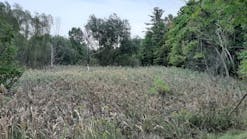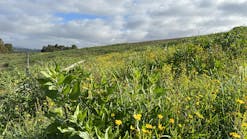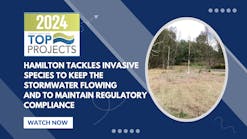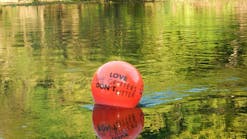Maintaining Turf on Golf Courses and Playing Fields
You’ve got bald spots around the soccer field goal posts, bare spots in the middle of the football field, a path worn through the grass in a favorite community park, three golf course fairways that look like Hannibal just trekked through trailing 30 elephants. What can you do? A lot, it seems (aerification, topdressing, overseeding, extra water, and fertilizer), as long as you first acknowledge that maintaining high-traffic areas means taking a good, solid look at what you’re up against and keeping your organization and your end users educated about what maintenance is needed and why, and as long as you’re willing to live with a certain amount of trial and error. The goal is proactive management. The key is to control traffic and facilities use before they become problems.
“There’s a lot you can do,” says Jim Snow, national director for the USGA Greens Section in Far Hills, NJ, “but you have to do a lot of things. It’s not just one thing, and it’s not simple. It requires a lot of work in a lot of different ways, and if you really mean to do something about wear and tear on turf, the costs are going to add up.”
Long-Term Planning
Without doubt, the best strategy for maintaining high-use areas is to head off overuse before it begins. “There are a hundred different scenarios you can look at for getting grass back into an area,” notes David Minner, associate professor and turfgrass specialist at Iowa State University in Ames, “but what it really comes down to is being able to control or limit traffic. It’s a matter of allowing enough time for these areas to recover.” Snow agrees. “Golf courses use various types of blockades and ropes to move traffic around. These things work if you stick with them. On golf courses, carts are the worse offenders, and a common strategy is limiting traffic to paths under bad weather conditions, when compaction and turf wear can be worse, and in steep areas that are subject to erosion. It’s a matter of priorities, resources, and user expectations.”
“A playing field is a resource,” states Minner. “You can’t just let everybody and their brother use a field, especially when you don’t have any income coming back for repairs and maintenance. There are ways to regulate programs: You can charge for use or you can cut down on use, but neither is going to happen until you get the ear of somebody up above who can help with the decision-making process.” Minner is quick to acknowledge the Catch-22 that grounds managers are caught in: A public park or field is there to serve the community, but too much use can destroy its utility.
In addition, there’s more than aesthetics and utility involved, points out Doug Fender, executive director of Turfgrass Producers International in Rolling Meadows, IL. “The cheapest thing a parks and recreation director can do is buy liability insurance,” continues Fender. “I say this half in jest and half seriously. Little Johnny runs out on the field and sprains his ankle. All of a sudden he was going to be an Olympic or professional soccer player worth millions of dollars, and your bad grass just made that impossible.” Although Fender thinks more public parks are waking up to the fact that there’s a risk potential, especially with areas that get high use, this new awareness doesn’t necessarily mean that administrators understand what is required for adequate maintenance, the costs, or how much good maintenance practices can antagonize end users. “Last year I met with some of the people of the National Recreation and Parks Association who maintain sports fields,” recalls Fender. “They’re under horrendous pressure without adequate budgets and with screaming coaches and parents on their backs. Grounds managers need to be able to explain to administrators the challenges they face and the relative cost-benefit ratio if those problems are going to be addressed.”
Minner recommends developing a cooperative relationship with the people who use the facilities that you’re in charge of maintaining. “Sometime during the year,” he says, “the people who manage parks and fields sit down to figure out the event schedules for those fields, whether it’s the community soccer league, the kids’ baseball league, high school football, whatever. This is the time to make your case for how the proposed use of a field is going to affect its condition. You have to be in there demanding downtime, and you have to be specific about just what that entails. You can’t make your case on August 15 if your fall soccer season starts September 10. It’s a done deal by then.”
Most important, Minner notes, is to know what the “true” activity for the park or field is likely to be, not just the number of football games, but how many other activities, what kind of use and when – band practice, rock concerts, and so on. Next comes pinpointing your windows of opportunity for maintenance. “We can talk about all those things that are agronomically important,” he says, “but the absolutely biggest thing that can change the impact on a field, its appearance, and how much grass you have is the decision that doesn’t cost any money – traffic control. If you’ve got three fields, plan for taking one out of service each year. Get the people who will use the field to help you figure out how to schedule their activities to compensate for the one field not being available. They need to understand that while 95% grass cover may occur two months after seeding, this is far from the protective biomass that is need to form a protective, traffic-tolerant mat.”
Implementing a site-specific management program can also help. Allocate resources directly to sites where abuse is predictable and skimp on less damaged and less critical areas. Minner points out that the areas on a football field that require regular maintenance, for example, are usually six to 10 times smaller than the area of the entire field. Reduce what you spend on the sidelines and schedule additional coring, seeding, fertilizing, and topdressing (sand, clay, compost) for the most heavily used areas. Minner also recommends developing a safety checklist so users can see why and where accidents are likely to happen and what can be done to prevent them. He has also had success with encouraging players to buy into maintaining their positions on a field. After practice or between games, baseball outfielders can spread a mixture of seed, sand, and soil into the divots they create, for example, and fill in thin areas.
In Waukegan, IL, Parks Superintendent Mike Trigg agrees that public education is key. He has developed and stuck by a procedure where his department alone has the responsibility for closing fields under bad weather conditions, although he admits that enforcement isn’t easy. “All of this takes a large enforcement effort and personnel. One thing we’ve done with soccer fields is to go to portable goal cages. If there’s no goal on the field, they can’t play.”
One of the larger problems Trigg must manage is that some of the 40-plus areas he’s responsible for have activity on them almost year-round, which makes it difficult to rotate fields out for maintenance and puts additional stress on the turf. Soccer season runs from March to November, baseball practice starts in April. Youth baseball concludes by Labor Day, but then the adults take over with softball from September to November. As Snow points out, experience on year-round golf courses shows how heavy use during the dormant season can cause increased turf damage, in part because evapotranspiration is diminished. Soil stays wet and gets much more compacted than during the growing season.
“We work closely with the recreation department field supervisor to schedule downtime, both resting and renovation periods,” says Trigg. “What we do during those periods when a field isn’t being used involves a lot of trial and error. We take a field out of use for maybe a six-month period, starting with Labor Day until the following spring, and depending on conditions, we do pretty much a complete renovation job. We use outside contractors for some of the work of grading, fertilizing, and weed control. The idea is to get the job done within the tight spring window when city crews might be busy on other jobs, such as moving. We do a very heavy topdressing and some light grading to fill in the birdbaths, level off the field, and then do a heavy overseed.” (Minner includes the use of outside contractors among his proactive management strategies on the opinion that it results in both time and cost savings.) Waukegan is currently considering a proposal for a large sports complex that will consolidate activities now scattered throughout the community in parks and school ball fields. One important management strategy includes incorporating two extra fields in the facility’s design so rotating fields for maintenance will be built in as a given.
On golf courses, golf-cart traffic is the most prevalent overuse problem, but Snow says its effects are felt more often in the rough than on fairway turf. “The fairways are often irrigated, fertilized, and treated with pesticides and the roughs aren’t. If the soil is dry, the grass isn’t going to grow, and if it gets traffic and it’s damaged, it won’t recover.” One solution is irrigation. “If you can run a line or two from the fairway to the rough, irrigation can help an awful lot with traffic tolerance. In low-budget situations where adding irrigation is not an option, the trick is to cultivate and overseed as you normally would to get some grass growing and then fertilize a couple of extra times. Then in the fall you do whatever renovating you can.”
One advantage golf courses have over parks and playing fields is that the people who use them pay to use them, and this means at least some money coming in for maintenance. And if players who use the facilities aren’t satisfied with conditions, there is always the option of raising fees to bring them up to snuff. (Trigg indicated that planners are considering user fees for the new sports facility being planned for his community. Adult leagues currently pay fees, but Trigg says they account for a very small part of the maintenance budget and go mostly for such supplies as chalk.)
To combat the effects of foot traffic on Waukegan parks and fields, Trigg developed another unconventional management strategy. “When we put in a new park or a playing field, we wait a year before we put in permanent walkways. We wait to see how people use the area and let them tell us where to put the path. It saves a lot of maintenance time and money.”
Treat the Problem, Not the Symptom
“It might seem easier to treat the symptom, but it’s more effective to identify and deal with the underlying problem,” says Fender. “You have trouble getting grass in an area shaded by trees. Instead of laying on more seed, trim the trees so you let in more light and air.”
“Trim tree roots if you have to,” advises Snow. “Or remove the tree and get rid of the problem once and for all. Again, park managers can take a cue from golf course managers who must cope with problems related to course location and dramatic site configurations. Terrain, especially, can be a challenge
Proactive management also requires being constantly up to date on problems that may develop at a site: drainage problems that pop up because of wear and weather, poor initial construction that can no longer be ignored, and soil conditions. “Soil can and does change,” states Fender. “When you add something to change the pH, for example, you have to remember how small the portion of what you add is and how large the area you are trying to change. Realistically you have to acknowledge that results will only be short-term, and over time, the soil is going to revert to the way it was. So every few years, especially if you’re having problems, say the grass thins out even after you’ve aerified, fertilized, and watered and you’ve satisfied yourself that it’s not a compaction issue, then a $10 soil test is a pretty cheap investment. If you’ve got bad soil, I don’t care what you do, you’re just going to be stuck refixing the fix.” Trigg reports that he aims for a soil test a minimum of every other year and uses it as a prescription for planning for the upcoming year. Crews collect samples, which are sent to the local extension service for analysis.
Fender considers compaction the most predictable problem from overuse and aerification its bottom-line solution. “Add water to soil compacted through use and it will eventually get to the point where it won’t spring back,” says Fender. “When this happens, core aerification is essential. It’s not a silver bullet, but it’s as close as there is to one. You save water, you get more efficient use of what water and fertilizer you do utilize, and plants will grow hardier, crowd out the weeds, and outgrow disease.” He recommends going down at least 2 in., depending on soil (3-6 in. is better); mowing the area as short as possible; aerifying in two directions; mowing again to chop up the cores; and then watering deeply. Avoid aerifying when the grass is under stress.
Trigg has used both core aerification with walk-behind equipment in the fall months for infields and sidelines (a reliable, low-cost method), deep tine aerifying (expensive but effective for getting down to the root area, especially on one field that was constructed in layers where the sand wasn’t properly mixed and blended), and slicing, which he says he found particularly effective after a period of drought. “It’s a great benefit just to break that surface, to break through the top layer, through the thatch, and get some moisture into the soil. We went through a very dry August this year, but we got some rain in September and did some slicing, and I think it really helped.”
Seed choice for overseeding might seem obvious (match what you’re using to what you’ve got in the ground), but Minner issues two cautions. He points out that rye grass is great for quick germination but doesn’t produce the needed thatch, which is what football and soccer games are played on. “Bluegrass is best for that purpose, so I always try to keep a component of bluegrass in the mix wherever I’m trying to grow cool-season grass,” says Minner. “There’s another thing we’ve been doing. It’s new but catching on: seeding Bermuda grass in the North. We seed it in the summer in really worn-out, beat-up areas because it’s hard to get anything else to grow. We know it’s going to winter kill, but we don’t care. At least we’ve got grass going into the fall. You let them play on it and you start seeding in your cool-season grass. When you come into the spring, the grass will be beat up anyway, which is when you start in with your cool-season grasses. If you don’t have any activity on it through the spring, it’s likely you can get fairly well caught up until May and June. Then you come back in with the Bermuda.” Minner notes that using cool-season grasses intermixed with warm-season grasses has been conventional practice in the South for years. “Everybody accepts that
“It’s important to stress that from seed to maturity takes a full growing season, almost 365 days. Nobody usually has that period of time, so you have to take advantage of every window of opportunity. The message is that you just keep the process going, maybe even seed as much as five times during the year. If you think you can get grass up in the summer, do it,” encourages Minner.
Having said that, he prescribes sod for small areas such as soccer goalmouths and those outfield areas where players dig their feet into the turf. “My theory is you budget for sod for the high-traffic areas that you know you’re going to lose regardless. If you don’t use the money, it’s gravy. In areas like this, under 5,000 square feet, it takes too long for seed to come up and it doesn’t last. If you budget to resod at least once a year, you’ll get instant grass that’s 18 months old.”
Fender believes a common error is underestimating the costs associated with seeding. “Most of the time, they look at materials only – a pound of seed versus a roll of sod – and seeding comes up cheaper. What they don’t think about is site and soil preparation and water to get the seed established, plus labor, equipment, fertilizer, and pesticides for two years, which is probably what it’s going to take to get the seed to the same maturity level. It’s like comparing the cost of a pound of angora wool to an angora sweater.” Fender also adds a remark shared by Snow: “What you have to look at is what you need to spend to get the quality you want.”
Think Big and Long-Term
“A common mistake many managers make,” Minner cautions, “is thinking you can grow grass on athletic fields and even germinate seed and be effective in a nonirrigated situation. Everybody grows grass without irrigation, and Mother Nature’s pretty kind in some situations, but if you want to force grow the grass and have it up and you’ve got a short window for doing it, an automated irrigation system should be a high priority. Rain trains and traveling guns are not bad – they’re better than nothing – but they’re really not very effective for germinating grass seed because they’re not very good at getting over the field with a shallow and frequent irrigation. You have to face the fact that using a portable irrigation system to establish grass in a short period of time is not that effective. Portable systems just don’t go across the field fast enough. When you put out grass seed or even pregerminated grass seed, you want to be watering three to five times a day with very light amounts of water. You can’t do that with a traveling gun. This is a really big case for irrigation – not only to irrigate seed initially, but in situations where you are constantly reestablishing grass, which is what you’re doing in any kind of overused area.
“One thing I’ve learned about lack of water,” Minner continues, “is that everybody has a drought almost every year. Drought is local, and it’s really bad for athletic fields where you’re seeding and forcing grass, which amounts to growing things in an unnatural climate.” He suggests encouraging volunteers from the community to become involved in raising money for such improvements as irrigation and/or budgeting for such projects on an incremental basis – one year buy the pipe, the next year install the pipe, the third year buy and install the heads.
What it boils down to is that there is no quick fix for maintaining heavily used areas. Worse, managers are discovering that the most successful strategies are not necessarily agronomic but require organizational and communication skills they must now take the time to develop. “Maintaining high-trafficked areas means putting together a whole series of things,” says Snow. “It requires an integrated approach. You’re trying to maintain growth under difficult conditions, so you try to improve every aspect of the conditions possible. The problem is chronic. You are always going to have these areas, and you really have to make an effort.”






